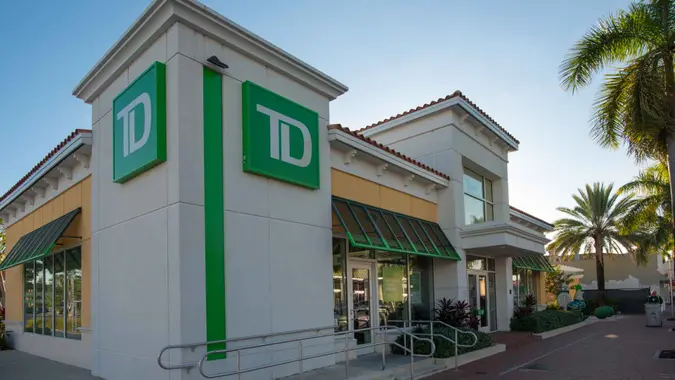The Biggest Bank in Every State

Commitment to Our Readers
GOBankingRates' editorial team is committed to bringing you unbiased reviews and information. We use data-driven methodologies to evaluate financial products and services - our reviews and ratings are not influenced by advertisers. You can read more about our editorial guidelines and our products and services review methodology.

20 Years
Helping You Live Richer

Reviewed
by Experts

Trusted by
Millions of Readers
Despite their reputation as impersonal and profit-driven, big banks do have certain advantages. Most offer a wide range of banking products and services, including online banking, credit cards and fee-free ATMs, as well as the convenience of numerous locations. It also turns out that in a good percentage of the 50 states, the biggest bank is actually a community or regional financial institution that aims to put customers first.
The Biggest Banks by State
GOBankingRates pinpointed the largest bank in each state, using a directory from the Federal Deposit Insurance Corp. to rank financial institutions by total deposits inside of their market, or within their home state.
| State | Biggest Bank | Total Deposits: Inside State | Total Deposits: Overall |
|---|---|---|---|
| Alabama | Regions Bank | $32,000,137,000 | $129,403,000,000 |
| Alaska | First National Bank Alaska | $3,874,988,000 | $3,874,988,000 |
| Arizona | Western Alliance Bank | $30,393,873,000 | $51,288,938,000 |
| Arkansas | Arvest Bank | $12,357,634,000 | $21,256,764,000 |
| California | City National Bank | $56,264,621,000 | $73,924,393,000 |
| Colorado | FirstBank | $22,513,871,000 | $24,394,244,000 |
| Connecticut | Webster Bank | $32,889,830,000 | $59,025,436,000 |
| Delaware | Discover® Bank, Member FDIC | $101,207,168,000 | $101,207,168,000 |
| Florida | Raymond James Bank | $38,533,176,000 | $38,533,176,000 |
| Georgia | Synovus Bank | $27,881,249,000 | $50,637,902,000 |
| Hawaii | Bank of Hawaii | $19,370,906,000 | $20,532,716,000 |
| Idaho | D. L. Evans Bank | $2,433,488,000 | $2,543,486,000 |
| Illinois | BMO | $94,598,704,000 | $202,237,154,000 |
| Indiana | Merchants Bank of Indiana | $12,879,192,000 | $12,879,192,000 |
| Iowa | Principal Bank | $7,668,816,000 | $7,668,816,000 |
| Kansas | Capitol Federal Savings Bank | $6,104,993,000 | $6,244,716,000 |
| Kentucky | Stock Yards Bank & Trust | $5,370,833,000 | $6,209,226,000 |
| Louisiana | B1bank | $4,237,010,000 | $5,036,399,000 |
| Maine | Bangor Savings Bank | $5,269,357,000 | $5,594,079,000 |
| Maryland | Sandy Spring Bank | $9,539,601,000 | $11,041,547,000 |
| Massachusetts | Eastern Bank | $17,881,861,000 | $18,302,604,000 |
| Michigan | Independent Bank | $4,557,023,000 | $4,557,023,000 |
| Minnesota | Ameriprise Bank | $20,933,401,000 | $20,933,401,000 |
| Mississippi | Trustmark National Bank | $9,855,320,000 | $14,989,813,000 |
| Missouri | UMB Bank | $26,636,936,000 | $33,660,048,000 |
| Montana | Glacier Bank | $7,614,605,000 | $20,126,170,000 |
| Nebraska | First National Bank of Omaha | $17,450,168,000 | $25,170,504,000 |
| Nevada | Wells Fargo National Bank West | $13,168,203,000 | $13,168,203,000 |
| New Hampshire | Bank of New Hampshire | $2,061,672,000 | $2,061,672,000 |
| New Jersey | Valley National Bank | $30,314,708,000 | $49,783,722,000 |
| New Mexico | New Mexico Bank & Trust | $2,366,444,000 | $2,366,444,000 |
| New York | Goldman Sachs Bank USA | $231,713,000,000 | $352,195,000,000 |
| North Carolina | Bank of America | $250,015,681,000 | $1,879,160,655,000 |
| North Dakota | Bell Bank | $4,904,390,000 | $11,664,721,000 |
| Ohio | U.S. Bank | $111,380,704,000 | $526,741,722,000 |
| Oklahoma | BOKF | $17,090,636,000 | $33,543,179,000 |
| Oregon | Umpqua Bank | $21,375,228,000 | $526,741,722,000 |
| Pennsylvania | First National Bank of Pennsylvania | $21,451,265,000 | $34,219,281,000 |
| Rhode Island | Citizens Bank | $14,890,521,000 | $180,714,166,000 |
| South Carolina | United Community Bank | $3,466,600,000 | $22,651,605,000 |
| South Dakota | Citi® | $452,108,000,000 | $757,135,000,000 |
| Tennessee | First Horizon Bank | $30,793,879,000 | $66,592,014,000 |
| Texas | Charles Schwab Bank | $271,772,000,000 | $271,772,000,000 |
| Utah | Ally Bank | $158,824,000,000 | $158,824,000,000 |
| Vermont | Northfield Savings Bank | $1,135,507,000 | $1,135,507,000 |
| Virginia | Capital One | $55,636,972,000 | $367,820,677,000 |
| Washington | Washington Federal Bank | $7,536,402,000 | $16,294,261,000 |
| West Virginia | WesBanco Bank | $4,232,695,000 | $13,140,134,000 |
| Wisconsin | Associated Bank | $24,667,366,000 | $32,061,546,000 |
| Wyoming | Pinnacle Bank – Wyoming | $1,071,044,000 | $1,123,563,000 |
Final Take To GO
The bottom line is that when it comes to financial decisions, you not only want all of your banking needs covered, but you also want to be able to conveniently pop into a local branch near you. It is good to know what financial institution could be the best fit for you in your home state or if you plan on moving.
FAQ
- What U.S. bank is in all 50 states?
- There are currently no commercial, consumer or investment banks in the U.S. with branches located in all 50 states, or all the states and Washington, D.C.
- Which bank has the most branches in the United States?
- For consumer banking and commercial banking, you can't beat Chase, as it has the most branches in the United States — over 4,700 in 48 states and Washington, D.C. It is also the biggest bank in the U.S. based on total assets.
- What is the No. 1 bank in America?
- There are many big banks in America, but Chase would be the No. 1 bank in the U.S. based on its total assets. Other contenders among the largest banks include Bank of America, Wells Fargo and Citi.
- Is PNC Bank in all 50 states?
- PNC Bank is not in all 50 states. There are currently no national banks located in all 50 states. This includes big banks such as Chase, Citi and Bank of America.
Joel Anderson and Jami Farkas contributed to the reporting for this article.
Methodology: GOBankingRates used the Federal Deposit Insurance Corp.’s directory to find the largest bank by total deposits inside of market — meaning deposits within the state. Banks must be headquartered in the state. Total deposit figures (inside and outside state) are for informational purposes, not ranking. In three states (Massachusetts, Pennsylvania and Utah), the second-largest banks are listed because the largest provide investment and wealth management services rather than traditional banking services. All data on deposits was sourced from the FDIC’s Deposit Market Share Reports – Summary of Deposits report as of June 30, 2023. All data used to conduct this study was compiled and verified on Jan. 22, 2024.
 Written by
Written by  Edited by
Edited by 
























